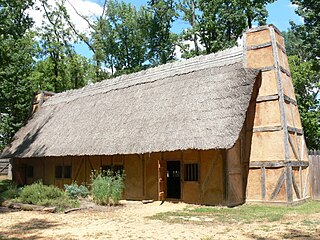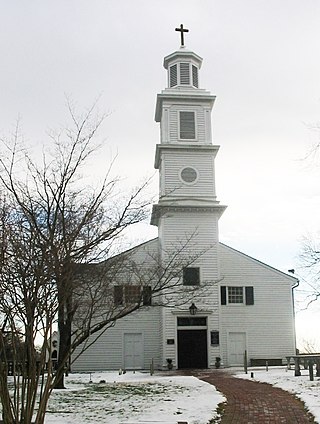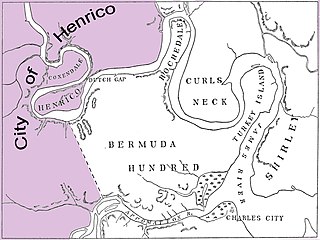Related Research Articles

The Jamestown settlement in the Colony of Virginia was the first permanent English settlement in the Americas. It was located on the northeast bank of the James River, about 2.5 mi (4 km) southwest of present-day Williamsburg. It was established by the London Company as "James Fort" on May 4, 1607 O.S., and considered permanent, after brief abandonment in 1610. It followed failed attempts, including the Roanoke Colony, established in 1585. Despite the dispatch of more supplies, only 60 of the original 214 settlers survived the 1609–1610 Starving Time. In mid-1610, the survivors abandoned Jamestown, though they returned after meeting a resupply convoy in the James River.

James City County is a county located in the Commonwealth of Virginia. As of the 2020 census, the population was 78,254. Although politically separate from the county, the county seat is the adjacent independent city of Williamsburg.

Charles City County is a county located in the U.S. commonwealth of Virginia. The county is situated southeast of Richmond and west of Jamestown. It is bounded on the south by the James River and on the east by the Chickahominy River.

The Colony of Virginia was a British, colonial settlement in North America between 1606 and 1776.

John Rolfe was an English explorer, farmer and merchant. He is best known for being the husband of Pocahontas and the first settler in the colony of Virginia to successfully cultivate a tobacco crop for export.

Elizabeth City Shire was one of eight shires created in colonial Virginia in 1634. The shire and the Elizabeth River were named for Elizabeth of Bohemia, daughter of King James I.

Charles City Shire was formed in 1634 in the colony of Virginia. It was named for Charles I, the then King of England, and was renamed Charles City County in 1637.

James City Shire was formed in the British colony of Virginia in 1634.

Sir Thomas Dale was an English soldier and colonial administrator who served as deputy-governor of the Colony of Virginia in 1611 and again from 1614 to 1616. Dale is best remembered for the energy and the extreme rigour of his administration in Virginia, which established order and in various ways seems to have benefited the colony, although he was criticised for high-handedness. He is also credited with the establishment of Bermuda Hundred, Bermuda Cittie, and the Cittie of Henricus.

The "Citie of Henricus"—also known as Henricopolis, Henrico Town or Henrico—was a settlement in Virginia founded by Sir Thomas Dale in 1611 as an alternative to the swampy and dangerous area around the original English settlement at Jamestown, Virginia. It was named for Henry, Prince of Wales (1594–1612), the eldest son of King James I.

St. John's Church is an Episcopal church located at 2401 East Broad Street in Richmond, Virginia, United States. Formed from several earlier parishes, St. John's is the oldest church in the city of Richmond, Virginia. It was built in 1741 by William Randolph's son, Colonel Richard Randolph; the Church Hill district was named for it. It was the site of two important conventions in the period leading to the American Revolutionary War, and is famous as the location where American Founding Father Patrick Henry gave his memorable speech at the Second Virginia Convention, closing with the often-quoted demand, "Give me liberty, or give me death!" The church is designated as a National Historic Landmark.

William Randolph I was an English-born planter, merchant and politician in colonial Virginia who played an important role in the development of the colony. Born in Moreton Morrell, Warwickshire, Randolph moved to the colony of Virginia sometime between 1669 and 1673, and married Mary Isham a few years later. His descendants include many prominent individuals including Thomas Jefferson, John Marshall, Paschal Beverly Randolph, Robert E. Lee, Peyton Randolph, Edmund Randolph, John Randolph of Roanoke, George W. Randolph, and Edmund Ruffin. Due to his and Mary's many progeny and marital alliances, they have been referred to as "the Adam and Eve of Virginia".

British America comprised the colonial territories of the English Empire, and the successor British Empire, in the Americas from 1607 to 1783. These colonies were formally known as British America and the British West Indies immediately prior to thirteen of the colonies seceding in the American Revolutionary War (1775–1783) and forming the United States of America.
Elizabeth City was one of four incorporations established in the Virginia Colony in 1619 by the proprietor, the Virginia Company of London, acting in accordance with instructions issued by Sir George Yeardley, Governor. This allowed the crown to benefit from the offerings of the new land, including its natural resources, new markets for English goods, and the leverage it provided against the Spanish.
James City was one of four incorporations established in the Virginia Colony in 1619 by the proprietor, the Virginia Company. The plantations and developments were divided into four "incorporations" or "citties" [sic], as they were called. These were Charles City, Elizabeth City, Henrico City, and James City. James City included the seat of government for the colony at Jamestown. Each of the four "citties" [sic] extended across the James River, the main conduit of transportation of the era.

The City of Henrico is one of the oldest counties in the Colony of Virginia. It was one of four incorporations established in the colony by its proprietor, the Virginia Company. The City of Henrico, which included the settlement of Henricus, was the furthest incorporation upstream on the James River. In 1634, Henrico was reorganized under royal authority as the shire of Henrico, one of eight shires in the Crown Colony of Virginia, Later, it became known as Henrico County, Virginia.
Colonel Edward Hill was a Virginia planter, soldier and politician. In addition to representing Charles City County for many terms in the House of Burgesses, fellow members three times selected him as its Speaker, and he sat in the Virginia General Assembly's upper house, the Virginia Governor's Council in 1651 as well as from 1660 to 1663. Burgesses also sent Hill to Maryland to put down Richard Ingle's 1646 rebellion, and he acted as the colony's temporary governor before ceding to the proper governor, Leonard Calvert, but later contested nonpayment of monies promised to him and Virginia militia troops for that action. Col. Hill also led the Charles County and Henrico County militia and Pamunkey Native Americans against other tribes in Hanover County in 1656, with less success.

The English overseas possessions comprised a variety of overseas territories that were colonised, conquered, or otherwise acquired by the Kingdom of England before 1707.
George Thorpe, was a noted landowner, Member of Parliament, distiller, educator and major investor in early colonial companies in the Americas.
References
- 1 2 Foley, Louise Pledge Heath (1978, 2002 reprint). Early Families Along the James River, p. vi. Genealogical Publishing Co.
- ↑ Long, Charles M. (1908). Virginia County Names: Two Hundred and Seventy Years of Virginia History, p. 31. The Neale Publishing Company.
- ↑ ""History", Charles City County". Archived from the original on 2016-05-29. Retrieved 2014-11-02.
- ↑ "Colonization", James River Plantations, National Park Service
- ↑ Hatch Jr., Charles E., The First Seventeen Years: Virginia, 1607–1624, The University Press of Virginia, Charlottesville, 1957